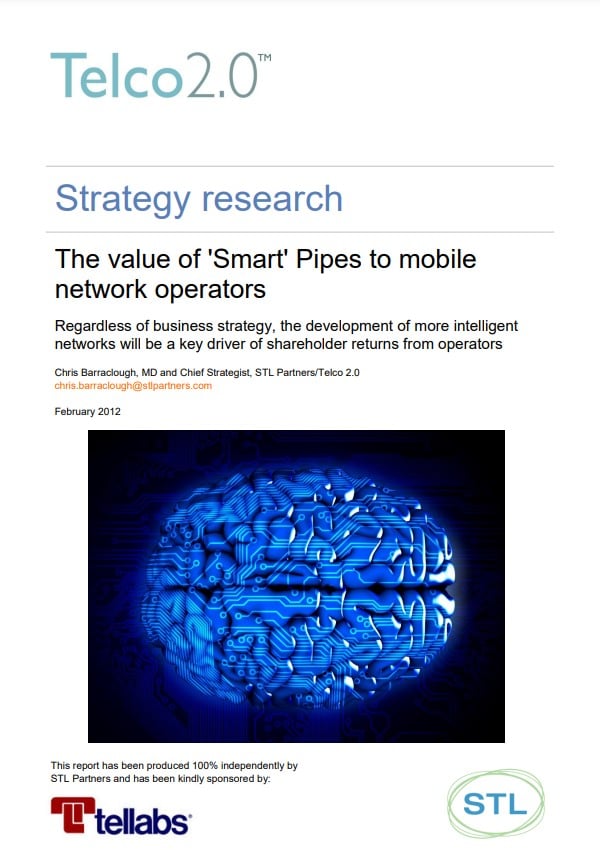The value of “Smart Pipes” to mobile network operators
£1,000.00 excl VAT
Regardless of business strategy, the development of ‘Smart Pipes’ – more intelligent networks – will be a key driver of shareholder returns from operators. Smarter networks will also benefit network users – upstream service providers and end users, and operators, and their vendors and partners, will need to compete to be the smartest. What are they, why are they needed, and what are the key strategies employed to develop them? (February 2012, Foundation 2.0, Future of the Networks Stream). Facebook user saturation bubble chart
Description
Format: PDF filePages: 71 pagesCharts: 28Author: Chris BarracloughPublication Date: February 2012
Table of Contents
- Executive Summary
- Mobile network operator challenges
- The future could still be bright
- Defining a ‘smart’ network
- Understanding operator strategies
- Video: Case study in delivering differentiation and cost leadership
- The benefits of Smart on CROIC
- Implementing a ‘smart’ strategy
- Conclusions and recommendations
Table of Figures
- Figure 1: Pressure from all sides for operators
- Figure 2: Vodafone historical dividend yield – from growth to income
- Figure 3: Unimpressed capital markets and falling employment levels
- Figure 4: Porter and Telco 2.0 competitive strategies
- Figure 5: Defining Differentiation/Telco 2.0
- Figure 6 – The Six Opportunity Areas – Approach, Typical Services and Examples
- Figure 7: Defining Cost Leadership/Happy Pipe
- Figure 8: Defining ‘smartness’
- Figure 9: Telco 2.0 survey – Defining smartness
- Figure 10: NTT’s smart content delivery system – a prelude to mobile CDNs?
- Figure 11: Vodafone India’s ARPU levels are now below $4/month, illustrating the need for a ‘smart network’ approach
- Figure 12: China Mobile’s WLAN strategy for coverage, capacity and cost control
- Figure 13: GCash – Globe’s text-based payments service
- Figure 14: PowerOn – SingTel’s on-demand business services
- Figure 15: Telefonica’s Full-service Telco 2.0 strategy
- Figure 16: Vodafone – main messages are about being an efficient data pipe
- Figure 17: Collaboration with other operators key to smart services strategy
- Figure 18: Verizon Wireless and Skype offering
- Figure 19: Content delivery with and without a CDN
- Figure 20: CDN benefits to consumers are substantial
- Figure 21: Cash Returns on Invest Capital of different Telco 2.0 opportunity areas
- Figure 22: The benefits of smart to a MNO are tangible and significant
- Figure 23: Telco 2.0 Survey – benefits of smart to MNOs
- Figure 24: Telco 2.0 survey – MNO chances of success with smart strategies
- Figure 25: Telco 2.0 survey – lots of moving parts required for ‘smartness’
- Figure 26: Telco 2.0 survey – Differentiation via smart services is particularly challenging
- Figure 27: Telco 2.0 survey – Implementing changes is challenging
- Figure 28: Telco 2.0 survey – Prioritising smart implementation activities
Technologies and industry terms referenced include: APIs, AT&T, Business Model, CDNs, charging, China, China Mobile, Differentiation, dumb pipe, Europe, Full-service Telco 2.0, Future Networks, happy pipe, Innovation, Location, M2M, mobile, network sharing, Next Generation Network, NGN, NTT, Payments, Smart, smart network, smart pipe, smart services, Strategy, Telco 2.0, Telecommunications, Telefonica, Tellabs, upstream, US, Verizon, Vodafone, yield


